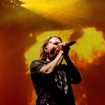"Master of Puppets is my favorite album," Kirk Hammett enthused when we talked with him in 2017 about the watershed Metallica LP and the massive reissue the band was putting out at the time. "We culminated as a band on Master of Puppets. Really! Everyone was kind of settled into their roles. Everyone was playing well. We knew what we were striving for, we knew what we could do, we knew each other's playing well, we knew our strengths. And it just kind of all culminated on this album."
Hammett is hardly the only person who would cite Puppets as their favorite Metallica record — the 1986 LP is hands down one of the Top 5 metal albums of all time, if not numero uno. The band were brash kids then, full of spit and fire, and they struck creative gold intuitively and magically, though not without a lot of hard work, too. Recording in drummer Lars Ulrich's native Denmark with producer Flemming Rasmussen, the Bay Area band crafted a masterpiece, working through the night, pulling from a wide array of influences, pushing each other and pulling in every trick they could think of. It was the beginning of Metallica, soon-to-be rock behemoth, and also the end of an era — the group's last recording before bassist Cliff Burton's untimely death. Below are 10 surprising facts, stories and trivia-ready tidbits about one of heavy music's most celebrated works.
1. Metallica recorded Master of Puppets in the dark — sort of
"For three months I don't think we saw daylight," Ulrich told us of the Master of Puppets sessions. The band would usually get started around 7 p.m. each day and work through the night til 4-6 a.m. "This was like September, October, November, December — so in Denmark, if you wake up at 4 in the afternoon, it's already dark ... We never saw daylight for the whole time, and my main recollection [of the recording sessions] is just how dark it was!"
2. Cliff Burton "took" one of Hammett's solos in "Orion"
Hammett says that the second bass solo in Puppets' iconic instrumental track was originally a guitar solo before Burton unceremoniously claimed it. "I remember recording it in the studio, and then I left to go back to the East Coast and meet a girl or something, I don't know," Hammett recalled in 2017. "Cliff went back to the studio, and used that area to put his own solo on it — but he played, like, half of my licks that were in the original solo! It was the weirdest thing!" But the guitarist says there were no hard feelings: "It wasn't really much of an issue for me, because there were like four guitar solos in that song — it wasn't like he took the only one."
3. David Bowie inspired the title of the song "Leper Messiah"
Glam-rock chameleon David Bowie was a somewhat unlikely influence on Metallica, as Hammett revealed on a 2016 episode of the One on One With Mitch Lafon podcast. In particular, he noted that the title of Master of Puppets cut "Leper Messiah" — a biting takedown of corrupt televangelists — was drawn from David Bowie's lyrics to "Ziggy Stardust," specifically the line "making love with his ego Ziggy sucked up into his mind, like a leper messiah."
4. Bowie was hardly the only non-heavy-music influence on Master of Puppets — Metallica were listening to a lot of Kate Bush, the Police and Simon & Garfunkel while writing the album, too
Aside from obvious influences including NWOBHM stalwarts Iron Maiden and Saxon and punk-rock rabble-rousers such as the Misfits and Discharge, the 'Tallica boys were also taking in much less headbangable sounds while composing Master of Puppets, which no doubt insinuated their way into the record. "[We listened] to a lot of Kate Bush," Hammett told us. "We'd discovered Kate Bush around that time. And we loved the Police — we listened to the Police all the time, because Cliff was a big fan of Stewart Copeland's drumming, and he loved the sound of his snare. He'd say, 'Oh, I love that snare!'" Ulrich says that they were even "finally appreciating Simon & Garfunkel for their amazing songwriting and harmonies."
5. Ulrich borrowed a snare drum from Def Leppard's Rick Allen for Puppets
According to Rasmussen, speaking to Rolling Stone, Ulrich was looking for a specific drum sound — that of a Ludwig Black Beauty snare — while in the studio. Since the only musician he knew who owned one was Def Leppard's Rick Allen, and he was recovering from the loss of his left arm in a car accident, Ulrich called up Allen's manager. "[Ulrich] said, 'Hey, Rick's not using the snare right now. Can you send it over?'" Rasmussen reports. "The next day it was there. They just overnighted it."
Below, watch Metallica play an epic rendition of Master of Puppets' "Disposable Heroes" live at the 2013 Golden Gods:
6. Metallica tuned lower than usual when recording the title track to get the sound as tight as possible
"Back then, it was all about getting it tight," Ulrich told us in 2017. "'It's gotta be tight! Every guitar track has to be totally tight to the other guitar tracks!'" Rasmussen recalls that in order to achieve the desired optimal sonic tightness, he had Metallica tune their instruments slightly lower than usual when recording "Master of Puppets" so they could mix with the tapes running faster and still have the end result sound in tune. "We banged it out a couple of times and decided on the one with the best feeling," the producer said to Rolling Stone, "because they'd have to play it live."
7. ...but today Ulrich thinks Master of Puppets "sounds a little too tight"
As much time and energy as Rasmussen and Metallica put in to get Puppets sounding as tight as possible, the band's more recent focus in the studio is almost the diametrical opposite, as Ulrich admitted in 2017: "Nowadays when we make records, it's about trying to make it sound as lively as possible, and as full of spunk and vibe." Not surprisingly then, when the drummer listens back at Puppets today, he finds it doesn't sound loose enough for his current tastes. "Back then ... so much time was spent trying to make everything super-tight, to the point of being completely anal," he said. "When I hear the record now, it sounds a little too tight for where my ears are in 2017, and it sounds like the master tapes got left in a reverb tank for too long."
8. James Hetfield has the notes to the bass part in the middle of "Orion" tattooed on his left arm
"For me, 'Orion' was Cliff Burton's swan song," Hammett said to Rolling Stone. "It was a great piece of music, and he'd written the whole middle section. It kind of gave us a view into what direction he was heading." It also makes the tattoo that Hetfield has on his upper left forearm a very fitting tribute to the bassist — one that the Metallica frontman points out and talks about in the video below.
9. The original cover painting for the album sold at auction for $28,000
When artist Don Brautigam conjured up the cover image for Master of Puppets — in just three days, using a combination of airbrush and paintbrush — he had never heard a note of music from the album, as he revealed in a 2010 interview with Revolver. Not even "Disposable Heroes," which is frequently cited as the reference for the soldier's helmet on the cross headstone to the far left. Still, he managed to create something iconic and timeless — and worth a pretty penny, too. On November 24th, 2008 — 10 months after Brautigam's death — the 17x17" painting was sold for a none-too-shabby $28,000 at Christie's auction house at Rockefeller Plaza, New York City. (The $35,000 final figure listed on Christie's site includes the buyer fees.) No word on who the purchaser was or where the artwork resides now.
10. Deviled Ham played a key role in the photo of Kirk Hammett on the back cover
When we interviewed Hammett in 2017 about Puppets, he shared a particularly amusing anecdote. "The back cover shot of me, where I'm giving a dirty look to the camera?" he said. "That was because, I had just become a vegetarian back then, and we were at the Donnington Festival — someone threw a deviled ham sandwich from the audience, and it fucking smashed right on my brand new black Jackson Flying V. And I was so fucking pissed! I looked over to the side, and I saw my guitar tech laughing, and I saw [photographer] Ross Halfin laughing, and I just gave them a dirty look, and then Ross took the shot. And that's the shot that's on the back of Master of Puppets!"













